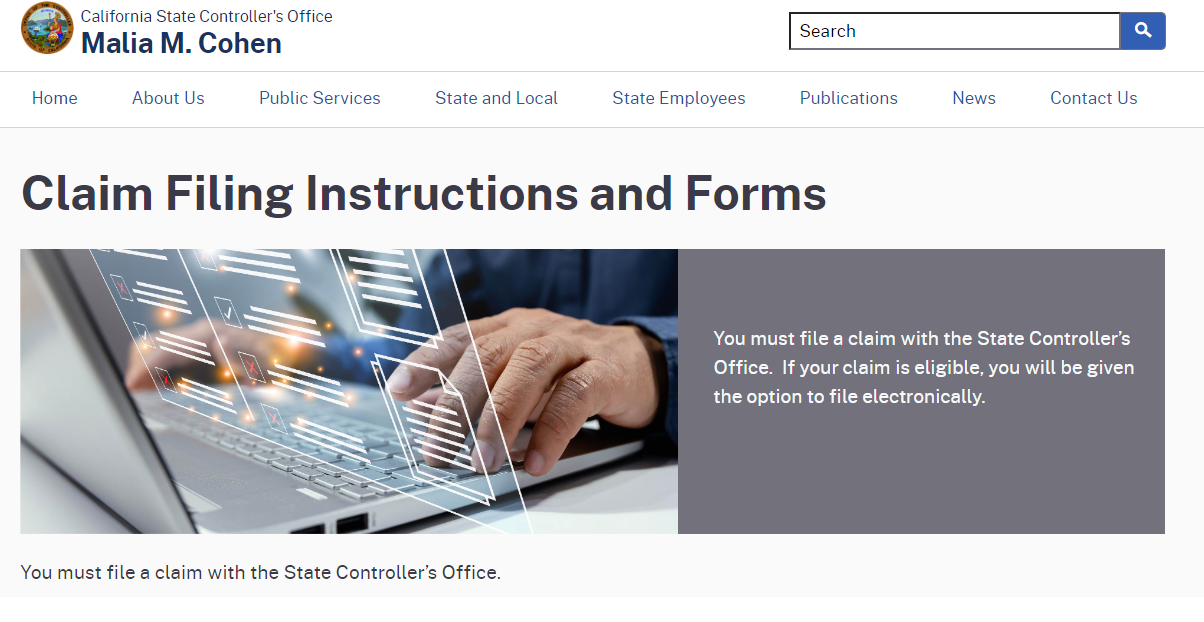Claim Unclaimed Business Property in California
Many business owners, whether operating a corporation, partnership, or other business entity, may not realize that thehttps://meetings.hubspot.com/rob-daniely could have unclaimed assets sitting with the California State Controller’s Office (CA SCO). These unclaimed assets can include vendor checks, accounts receivable credit balances, or rebates that were never cashed or processed. If unclaimed, these funds are eventually turned over to the state for safekeeping.
This comprehensive guide will walk you through the process of reclaiming your business’s unclaimed property, whether your company is still active, dissolved, or merged. With step-by-step instructions, this post will help you gather the necessary documentation and submit your claim successfully.

Step 1: Understanding the Types of Unclaimed Business Property
First, it’s important to know what types of business assets might go unclaimed. Here are a few common examples:
Vendor Checks: These are payments issued by customers or vendors that your business never deposited or cashed.
Accounts Receivable Credit Balances: Sometimes, clients or customers accidentally overpay or leave credits on your business’s books. These credits can end up unclaimed if not reconciled.
Rebates: If your business is entitled to rebates that went unclaimed, the issuing entity may have turned these funds over to the state.
These types of accounts, although seemingly minor, can add up over time, making it worthwhile to reclaim what belongs to your business.

Step 2: Gathering the Required Documentation
To reclaim your unclaimed business property, the CA SCO requires specific documentation to verify ownership. The required documents may vary depending on whether your business is still active, has been dissolved, or has merged with another entity.
Here’s a breakdown of what you’ll need:
Active Business
- Evidence of Good Standing with the Secretary of State’s Office
If your business is still operational, you must provide proof that the company is in good standing with the California Secretary of State. You can obtain this by requesting a **statement of corporate standing** from the Business Programs Division, Business Filing Section at the Secretary of State’s Office (located at 1500 Eleventh Street, Sacramento, CA 95814). - Tax Return
A copy of the business’s most recent tax return must be provided as further evidence of your business’s operations. - Authorized Officer Documentation
You will also need to submit a letterhead or business card for an authorized officer of your business. This proves that the person submitting the claim is authorized to act on behalf of the corporation or business entity.
Dissolved or Merged BusinessIf your business has been dissolved or merged, you’ll need additional documentation to prove ownership:
- Merger Documentation
In the case of a merger, provide copies of partnership agreements, merger documentation, or articles of incorporation to establish the continuity of ownership. - Dissolution and Wind-Up Documents
For dissolved businesses, you’ll need to submit any documents related to the dissolution and wind-up process, showing that all assets were accounted for and the business has legally closed its operations. - Final Tax Return
Provide the final tax return, which should show how any remaining assets were distributed when the business dissolved. This serves as proof that you are the rightful claimant to any unclaimed funds.

Step 3: What to Do If You Don’t Have the Required Documentation
If you cannot provide the required documentation, there are still options for proving your claim. In some cases, the CA SCO allows for alternative documentation if the originals are unavailable. Here’s what to do:
- Proof of Residence or Occupancy
If you don’t have the required business documents, you can submit proof of residence or occupancy at the address listed on the unclaimed property account as it was reported to the CA SCO. This could be a utility bill, lease, or another document tying your business to that address. - Additional Documentation
In cases where more information is needed, the CA SCO may request other documents to help establish ownership. Be prepared to provide additional proof if necessary, such as invoices, contracts, or internal accounting records that link your business to the unclaimed property.

Step 4: Submitting Your Claim to the California State Controller’s Office
Once you’ve gathered the required documents, it’s time to submit your claim. Follow these steps to ensure a smooth process:
- Download the Claim Form
You can find the business claim form on the [CA SCO website](http://www.sco.ca.gov). Be sure to download the form for business entities, as this will differ from personal claims. - Complete the Form
Fill out the claim form completely and accurately. Be sure to include all relevant business details, including the name of the business, federal tax identification number (TIN), and any additional information required. - Attach Documentation
Attach the required documentation, including your evidence of corporate standing, tax returns, and any merger or dissolution documents, as applicable. Attach Documentation - Submit the Claim
You can submit your claim online through the CA SCO’s secure portal or mail your documents directly to the address provided on the claim form. Submitting online is typically faster and allows for easier tracking, but both methods are acceptable.

Step 5: What to Expect After Submitting Your Claim
Once your claim has been submitted, the CA SCO will begin the review process. The timeline for this can vary depending on the complexity of your claim, but it generally takes several weeks to several months. Here’s what to expect:
- Claim Review
The CA SCO will review your documentation to ensure that everything is in order and that you are the rightful owner of the unclaimed property. If any additional documents are needed, the CA SCO will contact you for further information. - Additional Requests
If there are any discrepancies or missing information in your submission, you may be asked to provide further documentation. Responding promptly to these requests will help expedite the process. - Claim Approval and Payment
Once your claim has been approved, the CA SCO will release the unclaimed property. Payment is typically made by check or direct deposit, depending on the options provided. Keep in mind that no interest will be paid on the unclaimed funds.

Step 6: Preventing Future Unclaimed Property
While it’s great to recover lost assets, it’s also important to take steps to prevent business property from becoming unclaimed in the future. Here are a few tips to avoid this situation:
- Keep Track of Vendor Payments
Make sure all vendor checks and credits are processed in a timely manner, and follow up on any outstanding payments. - Update Business Information
Regularly update your business’s address and contact information with vendors, clients, and the Secretary of State’s Office to ensure payments are sent to the correct location. - Monitor Accounts Receivable
Keep an eye on your accounts receivable to ensure that credit balances are resolved and don’t end up as unclaimed property.
Final Thoughts: Reclaiming Unclaimed Business Property in California
Recovering unclaimed business property in California can be a straightforward process when you have the right documentation and follow the necessary steps. Whether your business is active, dissolved, or merged, reclaiming assets such as vendor checks, credit balances, or rebates can add significant value to your company.
If you’re ready to take action, gather your documentation, complete the claim form, and submit it to the CA SCO. The sooner you begin, the sooner you’ll recover what belongs to your business. If you need further assistance, don’t hesitate to reach out to experts who can help guide you through the process efficiently.

Comments are closed